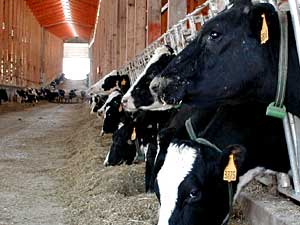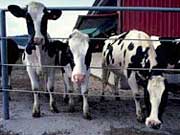Dairy farmers facing big changes
April 14, 2003
 |
| This barn on the Dwight Hasselquist farm near Le Mars, Iowa holds about 800 cows. (MPR Photo/Mark Steil) |
St. Paul, Minn — Big changes are taking place in the heart of Minnesota's dairy country. From the lakes and woods of central Minnesota to the hilly southeast, farmers feel they're caught in an economic vise.
Gary LeGare milks about 60 cows just north of the Minnesota River. He wonders if the dairy industry can survive.
"They're talking about losing 40 percent of the dairy farms in Minnesota in the next five years," says LeGare. "So that leaves 4,000 some left, when we used to have 40,000. You talk about the destruction of an industry."
There are still plenty of cows in Minnesota -- about half a million. But low prices and competition from farms in the western U.S. have taken a toll. Minnesota dairy farms are getting bigger and individual cows are producing more milk than ever. But that's not enough to offset an exodus from the business.
 | |||
In the last 20 years, the number of dairy farms in Minnesota has dropped 72 percent. The number of dairy cows is down almost 50 percent. Milk production is down 23 percent. No one is saying those busted farmers had a right to stay in business. But for dairy farmers like Gary LeGare, it's personal.
"I like what I do. You just don't get paid for it, that's all," says LeGare. "There's always hope, I guess."
But hope hasn't brought in much money the last year or so. Milk prices have slumped to historic lows, and LeGare is living check to check. He says everyone wants to help, but their solutions are too simplistic.
"You got these idiots running around in state government, these high rollers that smart off," says LeGare. "They don't know what this is like every day."
LeGare says the experts want producers to build bigger farms so they can milk more cows and make more money. The state Agriculture Department is pushing a program designed to encourage dairy expansion, but so far there's been little interest.
LeGare disagrees with the push to get big. He says small farms can be very profitable, if the federal government would step in and regulate milk prices. LeGare says right now, speculators on the commodity market take most of the profit out of milk.
 | |||
"The only institution big enough to protect our industries -- agriculture, steel, whatever -- is the federal government, from these blood suckers on Wall Street," says LeGare.
Most farmers agree with that. In a recent survey, the state Agriculture Department found higher prices number one on farmers' wish list. But better prices have been elusive.
The government has provided only token help, and rising national production tends to hold prices down. Most of that new production is in the western U.S., where the average dairy farm is 10 times the size found in Minnesota. A single California farm will have 14,000 cows when it's completed.
One farmer who followed the big farm model is Dwight Hasselquist. But in a move that underlines the poor condition of Minnesota's dairy industry, Hasselquist moved from Minnesota to another state to build his new farm.
"Northwest Iowa is a growing dairy area," says Hasselquist. "There's new dairies being built like ours. And there's existing herds that have been here for a long time that are expanding."
Hasselquist still considers himself a "Minnesota boy." But he left because he says the state's dairy industry is in bad shape.
"It's dying a slow death," says Hasselquist. "Minnesota's going backwards, substantially."
|
Don't give me this bull**** that we're overproducing, and then you tell us that we should get more efficient. That's a paradox you can't solve.
- Dairy farmer Gary LeGare |
Hasselquist built his new farm near Le Mars, Iowa. His 40 employees milk nearly 2,500 cows several times a day. From his office window he can see an ice cream plant, which played a big role in his decision to build here.
"Well's Blue Bunny Ice Cream is located right in Le Mars," says Hasselquist. "They are growing and have a great need for milk. So we knew that marketing our milk wasn't going to be an issue."
Marketing milk is a big worry for Minnesota farmers. Several processing plants have closed in recent years. Each closing hurts nearby farms -- they either have to find a new milk buyer or go out of business.
The problem is tied to Minnesota's declining production. Many small plants have closed because they can't find enough nearby milk. The larger ones can afford radical steps to stay in business.
Some are bringing in condensed milk from Idaho or New Mexico to keep their plants running. And in a sign of the times, a large Minnesota cheese producer bypassed its home state. Davisco Foods International is building a state-of-the-art cheese plant in South Dakota.
Ex-Minnesota farmer Hasselquist says the state must find ways to boost production. One way is to build bigger dairy farms. But there's resistance to that. Hasselquist says too many farmers are trapped by tradition, which he sums up this way.
"'We should dairy now the same way with what we grew up with. Dad did it in a certain way, so we need to keep doing that today,'" says Hasselquist.
This sense of tradition is the foundation for the most wrenching dilemma facing Minnesota's dairy industry. Should farms get larger, more like those found out west? That might turn Minnesota's dairy industry around. But at what price?
Some farmers say large dairy farms are an environmental threat. They say the huge amount of manure generated by the cows causes air and water pollution. Others fear large dairies will ruin them economically, by turning out torrents of cheap milk.
There's also a social dimension to the issue. Hasselquist says when he was still in Minnesota he made a modest expansion, going from 35 cows to 90. He says many farmers criticized him for that, and said the expansion was wrong.
"I think a lot of it is resistance to change," says Hasselquist. "Because then, if they see somebody else changing, 'Maybe I might have to at least consider it. And I don't really want to consider it, because I like my life right now and I don't want anything to change.'"
Most Minnesota farmers disagree with that. Many say they can't expand because it costs too much money. Or they don't want to go through the regulatory maze big farms face. Or they don't want to face the management headaches produced by a larger operation.
Others, like Gary LeGare, believe the traditional size Minnesota farm is the most efficient way to produce milk. He says it angers him that others don't realize that.
"Don't give me this bull**** that we're overproducing, and then you tell us that we should get more efficient," says LeGare. "That's a paradox you can't solve."
Small farms like LeGare's face an uncertain future. Federal subsidies have done little to help them. Milk prices the last year have been so low the subsidies hardly boost many farmers income to break even. And that's fueling gloom.
The Agriculture Department survey tells the story. It found one-third of Minnesota's small dairy farmers say there's a good chance they'll go out of business in the next 10 years.
|
News Headlines
|
Related Subjects
|

